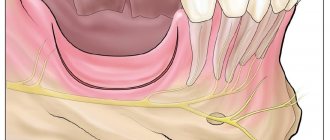You can love your family and friends, but not feel joy in being with them. Having an ideal job, but not feeling satisfied with it. Being bedridden, despite apparent physical health. The reason for this is depression.
In everyday life, the concept of “depression” is vague. This word is used to describe bad mood, sadness, depression, and reluctance to do something. All of the above may be symptoms of depression, but they are not. Sadness gradually goes away on its own and does not interfere with functioning in society - depression deprives a person of a full life.
What is depression
Depression is a mental disorder in which a person's activity and interest in life decrease.
According to the World Health Organization (WHO), depression affects approximately 350 million people worldwide. Less than 50% of them receive treatment, and in some countries less than 10%. Many patients do not seek help, unaware of the presence of the disease and blaming themselves for laziness or bad character.
What happens in the body during depression
With depression, the limbic system of the brain works differently - it is responsible for emotions, memory, sleep and other processes in the body.
Normally, the prefrontal cortex processes information received from the hippocampus and “slows down” the fear and anxiety that the amygdala activates.
Prefrontal cortex
Processes information Inhibits excessive activity of the amygdala Influences motivation and decision-making, regulates behavior
Hippocampus
Participates in the formation of emotions, the transition of short-term memory to long-term memory, as well as in maintaining attention
Amygdala (amygdala)
Activated when fear or anxiety occurs. Responsible for the formation of autobiographical memories associated with emotional outbursts.
During depression, the number of neurons and contacts between nerve cells decreases, the volume of the hippocampus and prefrontal cortex decreases, and the size of the amygdala changes up or down. Therefore, the prefrontal cortex cannot fully inhibit the activity of the amygdala and process information from the hippocampus - hence uncontrollable anxiety, depressed mood and lack of positive thoughts.
Prefrontal cortex
Information is processed incorrectly The activity of the amygdala is not inhibited => Motivation decreases, behavior changes, anxiety appears
Hippocampus
Volume decreases => Mood and memory worsen, concentration decreases
Amygdala (amygdala)
The size changes => Fear and anxiety are triggered; mental disorder develops
Depression is characterized by a deficiency of neurotransmitters - chemicals that transmit excitation from one nerve cell to another through networks of neurons. There is mainly a shortage of three mediators:
- Norepinephrine
- is involved in the inhibition of sleep centers in the central nervous system, is responsible for concentration, memory and motivation, and general motor activity. Affects how we react to stress and show emotions. - Serotonin
is responsible for sleep, mood, control of aggression, regulation of appetite, sensitivity to pain. - Dopamine
is responsible for feelings of satisfaction, love and affection, is involved in the process of learning and switching attention.
The production of endorphins is also reduced. They are responsible for “pain relief”, reducing the pain signal to a tolerable level - both during physical injuries and in a stressful situation. This explains the poor tolerance to stress and pain in people suffering from depression.
How does a person feel when depressed?
Depression is characterized by cognitive distortions—thought errors that prevent you from thinking rationally. “Nobody understands how much it hurts me”, “everything is bad”, “nobody needs me”, “everything around me is falling apart”, “I don’t deserve to live” - a feeling of loneliness and alienation accompanies everywhere, even if a person realizes that the facts do not support these destructive thoughts.
Any daily activity requires a lot of effort. Getting out of bed, meeting a friend, preparing dinner - a person with depression puts as much effort into these simple actions as a healthy person would into climbing Everest.
Previous interests, aspirations, desires lose their meaning. Food loses its former taste. Thoughts become confused, attention becomes scattered, mental acuity turns into lethargy. Appetite decreases or, conversely, increases if there is a habit of “eating” negative experiences. Insomnia or excessive sleepiness begins.
We invite you to take a look at the video, which shows the feelings characteristic of people with depression. Symptoms, feelings, and thoughts vary depending on the type of disorder and individual characteristics.
"Living with Depression" short film on Youtube. There are Russian subtitles.
General principles of psychotherapy for depression
Depression cannot be treated without psychotherapy, especially since patients suffering from this pathology themselves strive for this form of medical and psychological help, and most patients have a negative attitude towards pharmacological therapy.
Due to a feeling of helplessness, constant doubts, and pronounced self-hypnosis, patients with depression, reading the annotations for certain medications, easily discover side effects in themselves already in the first days of treatment. Due to a violation of the autonomic nervous system, they often have functional disorders of internal organs and, because of this, are really sensitive to the side effects of drugs. Many patients experience false alarms about ongoing dependence on antidepressants. All of the above determines the increased interest of such patients in psychotherapy.
As the results of many studies have shown, normalization of endocrine parameters during the treatment of depression is achieved not only during treatment with antidepressants, but also with the help of psychotherapy. Moreover, the effect of psychotherapy on endocrine indicators is observed both in the case of its combination with psychopharmacological therapy, and in the case of its use as the only method of treatment (Dinan T., 1994).
The onset of depression after acute mental trauma or a prolonged state of stress leads to a persistent search for the psychological causes of its occurrence. This circumstance increases the desire of patients for psychological help. However, excessive overestimation of its capabilities can lead to a complete refusal of psychotropic drugs, the formation of resistant and protracted variants of the course of depression, and the occurrence of its early exacerbations.
From the point of view of traditional psychiatry, in the process of treating depression, psychotherapy should first of all be aimed at eliminating the symptoms of individual symptoms of suffering. Some symptoms of depression are more sensitive to psychotherapy, while others are relatively difficult to respond to. It is well known that in severe depression the possibilities of psychotherapy are more limited than in mild cases of the disease.
The targets of psychotherapeutic treatment for depression include disorders of mood, thinking, behavior, motivational and physiological symptoms.
Among the affective symptoms, sadness, guilt, and especially anxiety are especially sensitive to psychotherapeutic effects, since these feelings are most often caused by the patient’s personality characteristics.
The psychotherapist’s tactics may change at different stages of treatment for depression. In some cases, with severe depression, in order to temporarily relieve the patient of an unbearable feeling of melancholy, the psychotherapist may need to induce tears in the patient and awaken self-pity.
If the patient, sincerely talking about his feelings, meets with reciprocal empathy, then “emotional cleansing” occurs, relaxation, partial liberation from painful emotions. This is at least temporary, but it alleviates the patient’s condition.
Manifestations of emotional release are especially noticeable and important in the initial stages of psychotherapeutic work, since it is during this period that the patient strives to share his feelings and encounter consonant experiences. He is impressed by everything that corresponds to his emotional state. So, in particular, he enjoys listening to sad music, but as he recovers, the same music that previously alleviated the condition can cause irritation.
Patients with depression are extremely reluctant to remain alone, look for people prone to the same conditions, and constantly compare themselves with them. At first, when communicating with other patients, they temporarily experience relief and feel better. However, frequent complaints from other patients soon begin to cause irritation.
Patients with depression, when telling close people about the feelings they experience, especially often focus the latter’s attention on the sensations, try to describe them in detail, find the reason for their occurrence and ways to eliminate painful experiences. Complaining about one’s health temporarily alleviates the patient’s condition, however, prolonged conversations about negative feelings and unpleasant sensations ultimately weaken the suffering person, causing a feeling of helplessness, irritation and fatigue in loved ones. Another thing is a psychotherapist who can “meter the conversation” with a patient suffering from depression. In addition, if a psychotherapist talks about patients with similar experiences, a history of developing depression and recovery from this suffering, then he can achieve a decrease in the severity of depression in his patient. Information about the successful recovery of other people from depression strengthens the patient’s faith in his own recovery. At later stages of treatment, role-playing games in which the therapist plays the role of a depressed patient also help improve the patient's condition. The psychotherapist's story about his experiences in the past alleviates the patient's condition, helps to establish good contact with the doctor, and the formation of warm and trusting relationships. From the point of view of some psychotherapists, the feeling of sadness can be weakened by causing anger and irritation in the patient, however, this is not always useful, since the patient is already quite exhausted by his protracted emotional state.
A person suffering from depression, in order to cope with an attack of melancholy and anxiety, usually tries to switch his attention to anything. He can count steps, look at objects, try to distract himself with conversation, watch TV, however, thus avoiding these symptoms of depression, after some time he again falls into its network.
According to A. Beck et al (1979), a psychotherapist can take advantage of this patient’s experience by developing and improving techniques of distraction. For this purpose, the patient can be taught the skills of sequentially turning on different analyzers (vision, hearing, tactile sensations, taste, smell), for example , with a detailed description of any object or event. In addition, the patient can form in his imagination a detailed positive image of the past, present or future (one should be careful in terms of induction of negative images by contrast), images of complex geometric figures, and recall paintings by masters of painting. In some cases, the patient should be asked to sequentially transform negative images and events into neutral ones, then positive ones, and exaggerate the negative image, achieving a weakening of negative experiences through humor. It is no coincidence that many famous satirist writers who themselves suffered from depression fought it with the help of irony.
Considering the fact that most often a feeling of melancholy or anxiety occurs in paroxysms, the patient can be taught skills to stop these manifestations of depression by diverting attention to other activities (creativity, playing, walking, reading, talking on the phone, writing, etc.).
The patient's belief that he will always be depressed must be shaken with the help of logical refutations. Various figurative comparisons are appropriate here, for example, the condition of a patient is compared with the condition of a person caught in the rain. The rain cannot continue indefinitely, and when it ends, depression will stop. Typically, patients with depression are sensitive to figurative comparisons and metaphors; they retain a sense of humor, with the help of which, as mentioned above, can also temporarily improve the patient’s condition.
It is better to build communication with a patient suffering from depression not in the context of a bilateral relationship, but in the presence of another person. Despite the fact that a patient with depression strives to get away from this, in the end, he will benefit. In addition, the person next to the patient who is emotionally involved in the patient’s negative experiences will suffer less. It is important to involve other specialists (psychologist, social worker), people, preferably of a different age, profession and gender, in cooperation. In this case, the patient is more likely to reveal his experiences, and most importantly, having encountered different points of view, he will begin to realize the ambiguity of any negative choice.
Long-term work with patients suffering from depression leads to the idea that it is possible to bring the patient out of this condition if the doctor is armed with great patience and is able to provide the patient with a kind of appropriate positive “psychiatric care”, intelligently helping the suffering person. An example can be given here. As you know, a person suffering from depression does not enjoy what he does and what brought him joy in the past. In order to cope with this symptom, it is necessary, together with the patient, to make a list of what gave him pleasure in the past, adding to this list all those ordinary pleasures that most people in the world value.
Traditional list of pleasures:
- Make small, but new discoveries for yourself
- Learn a new skill
- Cup of tea or coffee
- Confectionery, especially chocolate, fruit
- Visiting a store, useful purchases for the home, buying clothes, jewelry or souvenirs
- Meeting with close friends
- Physical activity, sports
- Visiting a restaurant
- Try a new dish
- Making love
- Games with children or pets
- Reading an interesting book, preferably with illustrations
- Drawing
- Photo
- Dancing
- Warm bath or shower
- Walk along the seashore
- Spending time with family
- Excursion, museum, short trip (preferably near water)
- Attending a sporting event
- Massage
- Visiting a theater, concert, cinema
- New hobby or old one
- Board games, billiards and tennis
- Swimming pool and sauna
- Long walks in the forest or near a natural body of water, horseback riding
- Bonfire in the forest or fire in the fireplace
- Gift for a loved one
- Traveling by car to new places
- Visit to the zoo
Speaking about the general principles of psychotherapy for depression, it is important to note the importance of the doctor’s control over his own feelings in relation to the patient. A psychotherapist who works with a patient suffering from depression often experiences a feeling of emptiness, irritation, and fatigue. To avoid this, the psychotherapist must not only sympathize with the patient, but also carefully observe him, maintaining a certain distance. In the process of therapy, it is necessary to strictly regulate the time of communication with the patient, to maintain the structure of the progressive movement towards recovery. Actively asking targeted questions, being confident in the diagnosis, and providing real hope are the basic rules for treating depression. Numerous studies have shown that hope received from a doctor is retrospectively rated by patients as an important aid in the process of overcoming depression.
The peculiarity of a psychotherapist’s work with a depressed patient is not so much empathy as understanding the condition and, in particular, the possibility of severe episodes of negative mood changes. Often the patient seeks to “paralyze” the psychotherapist with his endless expectation of help, and the latter makes the mistake of embarking on theoretical explanations and an endless search for somatic and psychological causes of depression. In fact, the psychotherapist should strive to ensure that the patient pays attention to himself, his character and looks for ways to adequately perceive his situation. It is undesirable to talk with the patient about the symptoms of his condition; it is much more important to emphasize the dependence of their severity on various situations, to talk about the characteristics of character and relationships with other people. The psychotherapist's compassion usually increases the patient's expectation of help, an attempt to reduce the severity of symptoms leads to their intensification, and consolation leads to inconsolability. It is important to lead the patient to the need for self-help, rather than to console him.
When a depressed patient finds it difficult to formulate his thoughts, a psychotherapist can help him with a simple statement or demand: “Tell me more about this.” In some cases, the therapist repeats or reflects what the patient has said, demonstrating understanding of the patient's feelings and thereby providing the patient with the opportunity to become more open with the therapist. During the conversation, you should abandon medical and psychological terminology. You should not rush to prematurely dissuade the patient regarding his views on the severity of his condition by telling him phrases like: “You will definitely get better,” “Everything will be fine,” or “There is nothing serious in your condition.” Ill-considered consolation of a patient often increases the patient’s anxiety, since the latter gets the impression that the doctor’s statements are ill-considered and his unwillingness to understand the condition of the suffering person. It is important to constantly clarify. What does the patient himself think about his condition, rather than getting off with a short consoling phrase. It is advisable to avoid questions that begin with the word “why”, since the patient, due to a depressive state, will most often consider his answers to be incorrect, his doubts will intensify, and negative thoughts will appear in relation to his mental capabilities.
In many ways, psychotherapy for depression is based on the patient’s identified resources. Such resources can be the patient’s skills with which he successfully coped with his difficulties in the past, his achievements, experience of positive self-esteem, professional success and support from friends or family, and hobbies. It is useful to ask what qualities of his character the patient is proud of, what appeals to him about himself.
When meeting someone with depression for the first time, you should not shy away from the topic of suicide. It is well known that by asking about this, the doctor does not increase suicidal intentions. The following sequence of questions is recommended: “Have you considered hurting yourself?”, “Have you ever had thoughts about death?”, “Do you want to die?”, “Have you thought about killing yourself?”, “Have you tried to kill yourself?” you do this and how?”, “What contributed to these attempts? “What stopped you from committing suicide?” As a result of the conversation with the suicidal patient, an agreement should be concluded with him to renounce suicidal intentions. The doctor must carefully analyze the answers to the questions, identify factors that contribute to suicidal thoughts, and assess the degree of risk of past suicide attempts.
| Find out more: Treatment of depression in our clinic |
In the process of psychotherapy for depression, the emphasis in choosing the points of its influence (“target of psychotherapy”) may shift depending on the stage of treatment, the patient’s condition, the method used or the characteristics of the psychotherapist’s working style. A discrete approach to choosing the target of psychotherapeutic influence and its consistent shift depending on the patient’s condition seems justified. In order to increase the level of control over the dynamics of therapeutic changes (both on the part of the psychotherapist and on the part of the patient), it is important to maintain transparency and openly discuss with the patient what is the focus at this stage of depression therapy.
A logically constructed scheme of sequential psychotherapeutic influence usually appeals to the patient. If a psychotherapist explains something that was previously incomprehensible, then he thereby builds trust in himself.
It is important for the psychotherapist that the patient reliably records in memory what happened during the therapy session. In some cases, this requires recording a session on a dictaphone, recording by the patient of the main points of a psychotherapeutic conversation, or a written report about his experiences, compiled after the end of the session. We believe that it is useful to ask the patient to carry a voice recorder with him for some time ("daily monitoring" using a voice recorder is possible) and at the moment of deterioration of his condition to use it for recording. The main techniques that facilitate the assimilation of information received during a therapy session include focusing the patient’s attention on planning the session and briefly summing up the results after its completion.
The emphasis on changing the patient's emotional state seems to be the main tactics of the psychotherapist. Relaxation, which allows you to relieve internal tension, catharsis - facilitating the processes of emotional release, induced laughter - are possible levers for controlling the emotional state. In the process of working with the patient’s emotional state, it is advisable to distinguish between concepts such as feeling, emotion and mood. In addition, it is important to highlight the basic feeling that the patient is experiencing at the current moment in time. As a rule, it is difficult to single out one feeling that a person has; most often it is a range of experiences. However, in a mixed emotional state, it is possible to distinguish the core and those experiences that exist on its periphery around the central feeling (during the process of therapy, it is sometimes useful to make a diagram of the feelings experienced by the patient). You can determine not only the pole of emotions, but also evaluate their severity. A subjective differentiated assessment by the patient of the severity of his feelings, for example, in % or in points, control of fluctuations in the amplitude and duration of negative emotions is useful. To assess the emotional state, it is essential to observe the patient’s non-verbal signs (facial expressions, gestures, posture, etc.), the emotional accompaniment of his statements, as well as the use of various tests widely used in clinical psychology (for example, such as the Luscher test).
This or that emotional state of the patient induces the appearance of sensations, most often caused by changes in the activity of the autonomic system, the nuclei of which are located near the brain structures associated with emotions. An important aspect of the psychotherapist’s work is a thorough study of the patient’s sensations, usually manifested in his complaints or measured using modern psychophysiological equipment (heart rate, respiratory rate, galvanic skin response, etc.). The psychotherapist must determine the sequence of changes in his patient’s sensations, identify their connection with his emotional state, peculiarities of perception, statements and behavior.
For a psychotherapist, it matters what the patient thinks about his emotional state, about the sensations that he experiences. How he interprets and evaluates changes in depressive symptoms. The assessments that the patient uses influence how he defines the reality around him. In the process of psychotherapy for depression, it seems that they arise almost automatically and are recorded in advance in the patient’s memory. According to psychotherapists working in the field of cognitive therapy for depression, there are at least three variants of thinking patterns that are located between a person’s feeling and action - these are assessments, inner speech and hidden basic knowledge.
When treating depression, relatively often the psychotherapist has to deal with the weakening of the patient’s will. In this case, the psychotherapist attaches particular importance to the patient correctly identifying the goal of his actions, strengthening the will with constant exercises, overcoming its weakness, controlling the direction of his drives and focusing his attention on those motivations that are the source of certain actions. In the process of psychotherapy for depression, working with the patient’s forms of activity is of particular interest. By changing the nature of your activity, you can influence many symptoms of depression at the same time.
In the process of psychotherapy for depression, one can encounter various quite complex therapeutic phenomena. One can consciously strive to achieve these phenomena, but sometimes the psychotherapist encounters them unexpectedly and, surprised by the improvement in the patient’s condition, remembers them after the psychotherapy session.
Psychotherapeutic phenomena are an integral part of a complex psychotherapeutic process, which reflects the dynamics of changes occurring in the patient’s mental sphere. The unclear boundaries of the phenomena of the psychotherapeutic process, their diversity and the desire of researchers of one or another school to designate the same phenomena using different terms make it difficult to describe these states. But the constant and unrealistic desire of psychotherapists to find the most effective method of psychotherapy for depression again and again forces us to return to those universal effects of psychotherapy, which in essence have been known since ancient times.
Probably the most well-known phenomena of the psychotherapy process are: catharsis (emotional release, response), insight (insight, understanding of events and phenomena), faith in recovery and coping (skills, self-control). However, it should be noted that in practice these phenomena often penetrate each other, combining in the process of psychotherapy. In Fig. Figure 1 depicts the main phenomena of the psychotherapeutic process and schematically shows their mutual influence on each other.
Rice. 1. The main phenomena of the psychotherapy process in the treatment of depression.
To one degree or another, each of the phenomena of the psychotherapy process carries an element of spontaneity and it can be assumed that even without professional psychotherapeutic intervention, the patient, independently or with the help of an ordinary person, is capable of achieving these states in a rudimentary form. When a person suffering from depression shares his experiences with someone close to him, when he talks to himself, trying to comprehend what is happening, when he hopes for a successful outcome of the illness and, finally, when he tries to cope with his feelings, understanding them or being distracted - then the lightning of these complex phenomena flares up. It is important to evaluate the manifestations of the phenomena of the psychotherapy process and determine how they affect the outcome of treatment? How universal are these states and the ways in which they can be achieved? The need to obtain answers to these questions is obvious, otherwise the therapeutic process will be closed, and actions will be determined by the therapist’s intuition and can lead to unexpected and unpredictable results. In some mysterious way, therapeutic phenomena are connected with the mechanisms of the therapeutic effect of psychotherapy and, we can say that they, like beacons, indicate the direction of movement towards the goal.
Rice. 2. Dynamics of the main phenomena of the process of psychotherapy for depression.
In Fig. 2. depicts the main phenomena of the psychotherapeutic process during the treatment of depression. Noteworthy is the “critical point” of the therapy process, which is the moment of psychotherapy when the patient can stop treatment.
Return to Contents
Types of depression
There are many classifications of depressive disorders. Some are no longer relevant, some are controversial. We tried to combine the main types of depression into subgroups, which are identified by ICD-10, the World Psychiatric Organization and some researchers (D. Hell, V. A. Torchilov, V. L. Minutko).
By severity
- Light
- difficult to distinguish from sadness and melancholy. The range of symptoms and their severity do not yet allow a clear diagnosis of depressive disorder, but with a high degree of probability a person will experience depression in the future. This condition is also called subdepressive or subsyndromal (minor) depression. - Moderate
- the clinical picture is clear, but the person is able to fully (or almost fully) function in society. - Severe
- pronounced symptoms up to loss of functionality, delusions or hallucinations.
By origin
- Endogenous
- does not depend on external influences, only on internal reasons - for example, due to heredity. - Reactive (exogenous, psychogenic)
- develops under the influence of external stress: death of a loved one, workload, breakup, etc.
It is often difficult to attribute depression only to endogenous or only to reactive - the disorder in most cases is caused by both external and internal factors.
- Primary
- depression is not preceded by other mental illnesses and is not caused by taking any chemical substances. - Secondary
- caused by other disorders and diseases (schizophrenia, alcoholism, brain pathologies) or taking drugs/medicines. Depression caused by somatic (“bodily”) causes is also called somatogenic.
By type of phase flow
- Unipolar (monopolar)
- the depressive state is stable throughout the entire illness. - Bipolar disorder (manic-depressive psychosis)
- the depression phase is periodically replaced by a mania phase - agitation, hyperactivity, elevated mood, outbursts of anger, etc. - Dysthymia
is chronic depressed mood for two or more years without severe symptoms. - Cyclothymia
is a “mild” form of bipolar disorder in which the mood constantly changes from elated and excited to depressed and vice versa. Mood changes are irregular and last several days.
According to seasonality
- Seasonal Affective Disorder
- Occurs depending on the season, usually in the fall or winter. - Non-seasonal disorder
- manifests itself regardless of the time of year.
By leading affect
- Anxious
- anxiety, concern, panic attacks predominate. - Melancholy
- there is a sad, melancholic mood, tearfulness. - Apathetic
- characterized by apathy, lack of interest in anything, dullness of feelings. - Undifferentiated
- it is impossible to single out any of the affects as leading.
By type of disorder in the motor or ideational sphere
- Inhibited (adynamic)
- characterized by impaired concentration, increased fatigue, memory impairment, and cases of inability to move and perform even simple actions. - Agitated
- symptoms include motor restlessness, a feeling of fear, rapid heartbeat, and strong emotional arousal. - Mixed
- combining signs of inhibition and agitation. - Dissociated
- without violations in these areas.
Disorders not included in subgroups
- Adjustment disorder
is an emotional disorder under the influence of severe stress that occurs during the period of adaptation to changes and interferes with a full life. - Atypical depression
- symptoms include specific signs: increased emotional reaction, weight gain, drowsiness, avoidance of interpersonal contacts. - Resistant depression
- refractory to treatment with antidepressants for at least two consecutive courses of 3-4 weeks. - Anxiety-depressive disorder
combines features of anxiety disorder and depression, and it is difficult to single out one as primary. - Postpartum (postnatal) depression.
Seasonal depression
The reason for the autumn blues is clear: sunny days are shortening, the air temperature is dropping - hence drowsiness, worsening mood and lack of energy. But “autumn depression” is not just melancholy. It cannot be cured by watching comedy series.
Experts use the term “seasonal affective (depressive) disorder.” Symptoms are similar to regular depression: loss of interest, irritability, poor concentration, changes in sleep patterns and appetite. More often than with other types of depression, overeating and excessive sleep occur.
Seasonal affective disorder occurs in the fall or winter. This diagnosis can be made if symptoms are observed at least twice during the cold season and not at any other time for two years or more.
While figuring out how to get rid of the autumn blues and depression, scientists suggested that the disorder is caused by a decrease in the level of sunlight. This affects the hypothalamus, which helps with the functioning of the nervous and endocrine systems.
Seasonal disorder also causes the brain to produce increased amounts of melatonin, a hormone that controls sleep-wake cycles. This leads to sleep problems, unexplained fatigue and apathy. At the same time, decreased levels of sunlight cause a decrease in the production of serotonin, which affects our mood, appetite and sleep.
How to cope with autumn depression? Doctors advise getting as much sunlight as possible during the day: going outside more often, sitting near windows and in well-lit rooms.
When thinking about how to get rid of autumn depression, you should make sure that it is not associated with stress, somatic causes or heredity. This can be clarified at an appointment with a specialist.
Depression in women
According to statistics, there are 2 times more documented cases of depression in women than in men (Tyuvina et al., “Gender characteristics of depressive disorders in women”). The cause of depression in women can be hormonal changes: changes in the menstrual cycle, pregnancy, miscarriages, the postpartum or premenopausal period, menopause.
Also, depressive disorders may include premenstrual dysphoric disorder, when a woman becomes depressed before the start of her cycle - more pronounced than with typical premenstrual syndrome (PMS).
A separate form is postpartum depression, which affects 13% of mothers. 50% of them had depressive tendencies even before pregnancy.
Young mothers spend enormous energy caring for their children, and therefore forget about themselves and their mental state. This is fraught with eating disorders, sleep disorders and other symptoms.
Before a woman fights depression on her own, it is recommended to consult a specialist. Maternal depressive disorder leads to disruption of the interaction between mother and child, which can lead to deviations in mental, emotional and physical development.
Depression in men
Perhaps the low number of reported cases of depression in men is associated with the stigmatization of this disorder in men (stereotypes such as “a man should be strong”, “a man should not worry about problems, but solve them”, etc.). This makes it more difficult for men to understand how to deal with depression and admit to having an emotion-related illness.
In some cases, depression is unconsciously masked by irritability and aggression, immersion in work and career, alcoholism and other addictions.
Depression in children and adolescents
Undesirable behavior of a child can be attributed to laziness or whims, but often there is a serious reason behind the reluctance to study, eat or sleep.
Even young children develop depression. The younger the child is, the more somatic symptoms he has: colic, pain, insomnia, constant crying. As the child's awareness increases, other signs appear: he loses the desire to get up in the morning, interest in toys and learning new things; attacks of fear and sudden mood swings appear. If symptoms persist for two weeks or more, you should meet with a psychologist who specializes in working with children.
Causes of depression
Several factors contribute to depression:
- Biochemistry.
With depression, brain activity and neurotransmitters change. - Genetics.
The influence of heredity on the development of depression was studied using the example of bipolar disorder. Direct relatives of bipolar patients are 15 times more likely to develop depression than relatives of healthy people. If one parent has the disorder, children experience depression in 25% of cases; if both parents - in 75% (Minutko V.L., “Depression”). - Personal characteristics.
People with low self-esteem may think that they are not worthy of love and recognition. With pronounced perfectionism, all energy is aimed at achieving an ideal result - burnout occurs. Individuals prone to dependence in relationships and living their lives through another person are also prone to depression: losing awareness of themselves as a separate unit and not leaving themselves personal space, when parting, they experience the loss of a loved one as the loss of themselves. - External factors.
Low standards of living and security in the country, social characteristics of the state (for example, oppression of minorities), incidents of violence (both physical and psychological), and the loss of a loved one can make a person more vulnerable to depression if he was initially predisposed to affective disorders.
Severe depression, what to do?
If a man, woman, teenager or your loved one has depression or severe apathy and he doesn’t want anything, and you don’t know what to do and you want to help him and support him, then here are a few rules that you should follow. The general rule is to avoid statements and phrases that focus more on your own anxiety in the face of a difficult, heartbreaking situation. Statements that place blame on the depressed person's willpower, lack of motivation, or negative mental attitude often backfire and increase feelings of isolation and hopelessness.
These statements sometimes come from a fundamental misunderstanding of the disease depression. It is a psychosocial condition that traps its victims in a closed mindset that creates vulnerable, despondent thinking patterns. Both men and women fall into a state of severe depression, and people fall into this state for completely different reasons, for example, due to the loss of a job or the loss of a loved one.
So what can we do and what should we say to support someone who is trapped in depression? How can you show compassion and understanding?
Symptoms of depression
Depression is diagnosed by a clinical psychologist, psychotherapist or psychiatrist. But you can determine the presence of depressive tendencies yourself. For this purpose, tests created by professors of psychiatry are used - the Zang (Tsung) scale or the Beck scale.
Main symptoms of depression:
- Persistent feelings of depression, anxiety, hopelessness, emptiness
- The desire for self-isolation, limiting contacts with loved ones, the desire to stay at home all the time
- Feelings of guilt, worthlessness, helplessness
- Tearfulness
- Feeling lonely
- Loss of strength, lethargy
- Problems with memory, concentration
- Vulnerability: a person with depression is easier to hurt and offend
- The feeling that no one understands, sympathizes, or loves
- Feelings of inferiority compared to other people
- Sleep disorders: insomnia, interrupted sleep or high duration of sleep, constant drowsiness
- Difficulty making decisions
- Feeling like thoughts are slipping away or getting lost
- Excessive overeating or lack of appetite
- Feeling that it takes a lot of effort to do simple things
- Loss of interest in activities and hobbies that previously brought pleasure
- Thoughts of death or suicide, suicide attempts, self-harm, desire to harm oneself, to “punish” oneself
- Symptoms of poor physical health that cannot be treated: headaches, digestive disorders, nervous tics, heaviness in the chest, heart pain, etc.
If you observe several symptoms simultaneously for 2 weeks or more, this is a reason to consult a specialist.
How do you know if you are depressed?
The line between “normal” sadness and depression as a disease is unclear, but there are symptoms that distinguish one from the other. Depression is a loss of interest in what is happening. A person functions in a slow rhythm, looks at the world gloomily and pessimistically, sees the future only in dark colors.
Common symptoms of depression
The most commonly cited symptoms of depression are:
- Feelings of loneliness, indifference, sadness, or regret about something
- Feeling tired and losing energy
- Reluctance to communicate with other people, even with relatives and friends
- Lack of interest in daily activities and responsibilities
- Constant feeling of dissatisfaction, tearfulness
- Excessive agitation, irritability, uncontrollable attacks of aggression
- Loss of appetite and sleep, decreased libido, weight loss or gain
- Inexplicable feelings of guilt, a sense of worthlessness of existence, helplessness, hopelessness, anxious and suicidal thoughts.
A diagnosis is the first response to signs of depression. The disease is diagnosed if at least four symptoms appear simultaneously and persist for at least two weeks.
Forms and causes of depression
The spectrum of depression is as wide as the number of patients diagnosed. We talk about depression when someone experiences mood swings associated with the season (seasonal depression) or psychologically traumatic situations (psychogenic form). The cause may be a difficult event, for example, the loss of a loved one (endogenous form), or biochemical changes that occur in the body in case of illness (somatogenic form).
Is there a difference between male and female depression?
There is no conclusive evidence indicating that female and male depression are different forms. Symptoms may be the same in women and men. However, statistics show that gender largely determines susceptibility to depression.
There are social, psychological and biological differences between the sexes.
Social differences
Experts say that up to 65% of cases of male depression remain undetected. This is evidenced by the fact that men are less likely to seek therapeutic help. Largely because they are ashamed of the symptoms and prefer to get out of depression on their own. Therefore, compared to women, they more often fall into alcohol and drug addiction.
Psychological differences
Male and female brains differ in their approach to problem solving. Women explore the cause of a difficult situation, analyze the past and consider its aspects. Men take concrete actions to solve the problem. In a hopeless situation, they are much more likely to attempt suicide. Forensic experts estimate that up to 80% of suicide cases occur in men.
Biological differences
Biological factors, such as physical appearance or hormonal factors, may also influence the development of depression differently in men and women.
How is depression expressed in women?
Depression occurs twice as often in women as in men. This is due to gender characteristics, hormonal factors, psychological perception of reality and behavioral style.
Factors influencing female depression:
Family status
This is one of the most common risk factors. Single women are less likely to experience depression than married women, while the opposite is true for men. This is explained by the influence of social roles. It is worth noting that this phenomenon is almost never found in certain cultural circles, for example, in Mediterranean countries, where women's care of the home is traditionally valued.
Family relationships
The risk of developing depressive syndrome in women is associated not only with the fact of marriage, but also with the quality of family relationships, which is often influenced by difficulties interacting with a partner. Lack of intimacy, trust, and protracted family conflict cause stress, which deprives a woman of a source of support and reduces self-esteem.
Professional situation
Unemployment increases the risk of developing depression. It has been proven that work makes women resilient to negative life events. It organizes, develops activity, determination and a sense of control.
Thought processes
Gender differences in thinking styles also contribute to the development of depressive disorders. Women typically have lower self-esteem than men and respond to negative events by focusing more on themselves and their emotions than on actions. It is more difficult for them to independently distract themselves from disturbing thoughts and, thereby, improve their well-being.
Postpartum period
Another risk factor is the postpartum period. This is influenced by pain associated with childbirth, rapid hormonal changes, and changes in the body. The confrontation with a new social role and the need to mobilize strength to take care of the child also act as stress factors.
Menopause period
This period is characterized by isolated depressive syndromes. Women who previously suffered from depression, had severe premenstrual tension, and experienced severe postpartum symptoms are more likely to experience such symptoms.
How is depression expressed in men?
Men are generally more likely to achieve power and success than women. They do not like to admit weakness, so they are less likely to talk about their experiences.
Factors influencing male depression:
Partnerships
Research shows that the most common cause of depression in men is problems in their marriage or relationships. Arguments and quarrels cause men physical discomfort, so they try to avoid them. And if it doesn’t work out, they withdraw into themselves and cannot get out of depression.
Sex
Depression causes a man to lose interest in his own body and, as a result, in sex. Antidepressants against this background only worsen the situation. Sometimes there is an increase in libido as a way to improve mood.
Pregnancy and children
It has been found that one in ten men experience psychological problems when becoming a father. The need to devote more time to mother and child leads to fatigue and the inability to concentrate on work. Depression is aggravated if the partner is in a similar state, if the relationship is not going well, or if there are financial difficulties in the family.
Lack of work
Losing a job, no matter the reason, can be extremely stressful. Research shows that one in seven unemployed men becomes depressed within six months of losing their job.
Retirement
Reaching retirement age and retiring can be difficult for a man, especially when his partner is still working. It is difficult for him to independently adapt to new living conditions.
Temperament
Depression is often found in shy men who do not have permanent relationships, and who find it difficult to defend their rights and get settled in life.
Diagnosis and treatment of depression
A clinical psychologist, psychotherapist or psychiatrist conducts a conversation with the patient, asks leading questions: how the symptoms manifest themselves, for how long, whether there has been a deterioration or improvement in well-being. Tests and questionnaires can be used for diagnosis. In some cases, the doctor will refer you to other specialists (for example, to a cardiologist if your heart is bothering you) to rule out physical causes of this condition.
Patients with depression are hospitalized in exceptional cases - for example, if there is a real threat of suicide or delusions and hallucinations appear.
The approach to treating depression depends on the cause of its occurrence:
- Depression is endogenous, that is, it does not depend on external circumstances.
The main method of treatment is pharmacotherapy. For anxiety and restlessness, sedative antidepressants are prescribed, and for apathy and melancholy - stimulating drugs. If symptoms of both groups are present, drugs of balanced action are used. - The disorder arose against a background of stress.
It is necessary to work out the causes of stress in psychotherapy. Together with a specialist, you will understand what mechanisms your psyche triggers and how to rebuild them in order to feel better. Such depression can be treated without medication, but if the symptoms are severe and the patient feels unbearable, the doctor may prescribe a course of antidepressants. - Depression is a reaction to somatic illnesses.
It is necessary to treat the root cause of depressive disorder and only then resort to symptomatic pharmacotherapy and psychotherapy.
Antidepressants have side effects: They should be taken only as prescribed by a doctor. If you feel that the drug has a strange effect on your mood and condition, be sure to contact a specialist again - he will adjust the dosage or select another treatment.
How to support a depressed person and what to do during depression
In general, the goal of supporting a loved one or friend with severe apathy or depression is to be caring and supportive, but also realistic and open to their state of mind. Each individual case of depression can be much more severe or complex than described here, especially if complex personality traits or problematic behavior or substance abuse problems are included in the equation. In general, accept the depressed person without expecting quick change or judgment, let him know that he is loved and not alone in his struggle and that you know how to help him in his situation. Your concern makes a real difference.
The information presented in this material is for informational purposes only and does not replace professional advice from a physician. If you notice signs of depression, consult a specialist!
Author: Editorial staff of the Help-Point.net portal
Start working with a psychologist right now
Start a consultation
Tags: test depression depression consultation with a psychologist depression help depression treatment psychologist online
Share
Comments
- Comments
Loading comments...
Previous article
Help for schizophrenia
Next article
How to deal with apathy and depression on your own
The best ways to combat depression are psychotherapy and treatment as prescribed by your doctor. However, there are several ways to deal with stress and depression on your own.
Any work, including psychological work, is not easy when you are depressed, but taking care of yourself will significantly speed up recovery.
Record your condition
A person prone to depression is not always able to express his feelings in words. In this regard, problems may arise in communicating with loved ones (when you want to share your problems, but they do not understand you) and in understanding yourself.
An exercise with a 10-point scale will help you understand what happens to you when you are depressed.
Idea taken from Learning Solution-Focused Therapy by Anne Bodmer Lutz.
Draw a line and mark it with divisions from 0 to 10. This will be a scale of your state, where 0 is the worst feeling, and 10 is the best possible feeling, a state of absolute happiness. Assign each division a list of “symptoms,” feelings, and thoughts. You can use metaphors and images that are close to you personally. Here's an example:
When you feel changes in your condition, ask yourself questions:
- How am I feeling now? Where am I now on a scale of 10?
- Is there something that could cause me to move left on the scale? What should I be afraid of? Can I protect myself from this shift?
- Is there anything that will allow me to move up the scale by at least one point? How about two points?
There is a difference between “I feel terrible” and “I feel 2/10 bad.” By rationalizing your condition, you increase the chances of its improvement. The scale will tell you what to do if depression does not go away.
Remember what makes you feel better
If something makes you feel even a little better, write down the reason. You liked the taste of food, listened to a friend, watched a funny video with cats - any event that brought a smile or smoothed out the feeling of pain and emptiness deserves attention. You can record how many points the improvement occurred after each event. Even if it is only one tenth, any positive change is worth recording.
During depressive episodes, you should turn to the list of positive things you have created and try to implement any of them.
Track your needs
Usually when you're depressed you don't want anything. It is all the more important not to miss the moment when the desire to do something does appear. Suddenly felt like you wanted to go for a walk? Go outside. Want to chat with friends? Call them.
If you just want to lie on the couch, allow yourself that too. By coming into conflict with yourself over procrastination, you only waste your internal resources, which are already scarce in depression. Try to put things aside and allow yourself to rest without remorse.
Process destructive thoughts
Depression is characterized by destructive automatic thoughts. These are judgments that arise fleetingly and most often are not based on specific facts (“nobody loves me,” “I’m worthless,” “I’m all alone”). Often a person is not aware of these thoughts, but he feels the emotions that arise as a result of them.
Information and exercise taken from the book “Mood Management. Methods and exercises” by D. Greenberger and K. Padesky.
According to cognitive behavioral therapy, you can learn to catch such thoughts and reduce the intensity of negative emotions. The easiest way to do this is using a table.
- When you feel a strong emotion, write it down and rate the intensity on a scale of 100. If you can’t determine what these feelings are, find a list of emotions on the Internet and listen to yourself, going through the concepts: which word resonates with you more strongly than others?
- Write down the situation in which this emotion arose. Where were you at this moment? Was there anyone else nearby?
- Try to isolate the thought (or several thoughts) that led you to the emotion.
- Try to use cold calculation: write down objective evidence that supports this idea, and facts that contradict it.
- Based on contradictory facts, formulate a new thought, more balanced and thoughtful. Rate how confident you are in her.
- Rate the intensity of the original emotion after formulating an alternative thought. Has the emotion weakened? Has it become easier?
Try to confirm your thoughts in practice, conduct experiments. If you feel like no one loves you, conduct a survey among your friends and family and write down the results. If you are afraid that you are performing poorly and will soon be fired, ask for feedback from your superiors. By receiving “applied” confirmation of alternative thoughts, the brain consolidates the new experience as positive, and the intensity of previous negative feelings decreases.
It is unlikely that after completing the exercise you will stop experiencing negative emotions. Perhaps their intensity will decrease by only 5–10 points out of 100 or not at all. But by filling out the table every day for several months, you will learn to replace destructive thoughts with more thoughtful ones and manage your feelings.
Here is a table with an example typical for a depressive state:
| Situation What happened? When, where, under what circumstances? | Saturday, 21:00. I'm home alone. |
| Emotions What did I feel? How intense are these emotions on a scale of 100? | Depression (100). Disappointment (90). Despair (90). |
| Automatic thoughts (images) What arose in my mind before the emotion arose? | I want to turn to stone so that I don't feel anything anymore. Life is not worth living. |
| Arguments for the Truth of Automatic Thought | My condition has not improved for several weeks. I try to force myself to do something, but nothing helps. |
| Arguments against the truth of automatic thought | I have experienced acute mental pain before, but somehow I dealt with it. Sometimes I feel lighter and don't feel as desperate. Sometimes I smile or laugh. I am learning to think differently and fill out this table, taking care of my condition. |
| Alternative/Considerated Thoughts Write down alternative or more balanced thoughts based on the arguments above. Rate your confidence in each of them on a 100-point scale. | It is important to realize that the feeling of unbearability of what is happening will definitely pass and your mood will soon improve (60). I am learning skills that will allow me to understand how to get out of depression (30). Suicide is not the only option (20). |
| Reassessing Emotions After becoming aware of alternative thoughts, rate on a 100-point scale the intensity of the feelings recorded earlier. Write down and evaluate new emotions if they appear. | Depression (80). Disappointment (75). Despair (70). |
Don't be shy to ask for support
The idea of asking for help is often accompanied by fear: what if the person refuses, laughs, or devalues the experience? Therefore, when dealing with depression, it is important to protect yourself and ask for support correctly.
- Try to determine what support is needed.
For some, these are supportive words (and you should immediately determine which ones), for others - a hug, joint leisure, just being nearby. - Identify people you can reach out to.
People whom we consider close are not always ready to provide support. Analyze your experience of communicating with a person: were there any cases when he ignored you or joked inappropriately? If yes, don't risk it. At the same time, it is not necessary to ask for support from relatives or close friends. Strangers, friends or colleagues can also support (pat you on the shoulder, listen, say kind words). - Request support.
People don’t know how to read minds, they may not know that you are feeling bad right now, and they may not understand what kind of support you need. Also, a person may be busy or immersed in his own experiences, so it is important to clearly formulate the request without pushing personal boundaries. For example: “I feel bad now and want to talk, can you listen to me, please?”
If asking for help is scary and uncomfortable, ask yourself: would I support this person if he turned to me? If yes, then why shouldn’t he support you?










